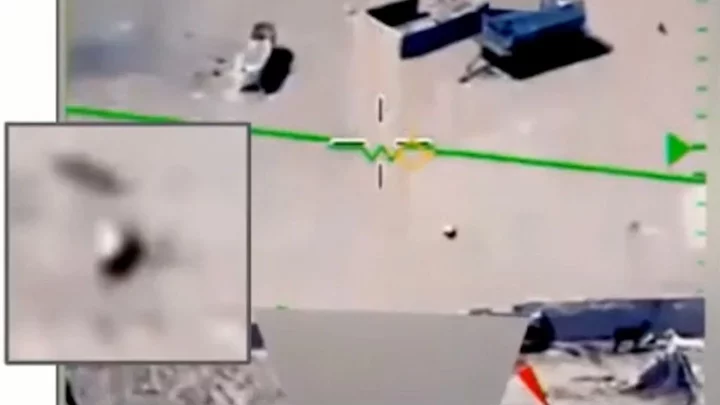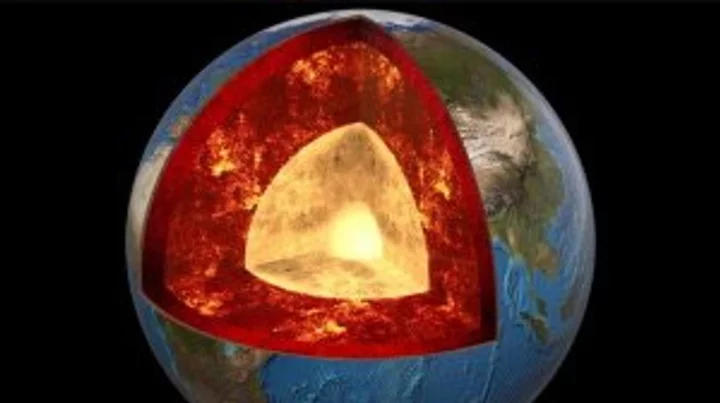
Binance plans to swap 750 million of token pairs to ensure liquidity
Binance said in a tweet on Monday it would swap 750 million tether-tron token pairs for tether-ether in
1970-01-01 08:00

Astronomers have finally figured out the source of the brightest explosion ever recorded
Astronomers believe they might have found the source of the brightest explosion ever in space. The record-breaking explosion recorded in October 2022 was the most powerful ever seen, leaving equipment and instruments struggling to measure it as it pointed directly at planet Earth. The bright gamma-ray burst is officially called GRB 221009A and when it first went off, scientists were left scrabbling to point telescopes in its direction to record it. The explosion has affectionately been nicknamed BOAT, standing for “brightest of all time”, and was caused by the death of a large star located 2.4 billion light-years away – relatively close in terms of space activity. The star collapsed into a black hole after ejecting its outer envelope, causing this huge, bright explosion comprised of gamma rays, producing not only a narrow structured jet but with an additional outflow of gas. Sign up to our free Indy100 weekly newsletter This “exceptionally rare event” surprised astronomers, who had not predicted the existence of gas, and certainly provides plenty of new information around the question of how black holes form. The study’s lead author and astronomer from George Washington University, Brendan O'Connor, explained: “GRB 221009A represents a massive step forward in our understanding of gamma-ray bursts, and demonstrates that the most extreme explosions do not obey the standard physics assumed for garden variety gamma-ray bursts.” He continued: “GRB 221009A might be the equivalent Rosetta stone of long GRBs, forcing us to revise our standard theories of how relativistic outflows are formed in collapsing massive stars.” The huge and long-lasting blast measured up to 18 teraelectronvolts which is a staggering record for a gamma-ray burst, leaving scientists to hypothesise that it was a supernova. Have your say in our news democracy. Click the upvote icon at the top of the page to help raise this article through the indy100 rankings.
1970-01-01 08:00

First pitch: 3 things I heard around MLB clubhouses last week
DENVER — Let's take a tour around the NL West in this week's First Pitch, with three things I heard from the Colorado Rockies, San Diego Padres and San Francisco Giants.With the Giants and Padres coming to Coors Field this week to meet the Rockies (and heading out of the Mile Hig...
1970-01-01 08:00

MLB Power Rankings: 1 biggest trade deadline need for every team over .500
MLB Power Rankings of the biggest need each club over .500 will need to win a World Series.If your team made this week’s MLB Power Rankings, it’s a good sign. Unlike last week when the teams below .500 were profiled, this week puts a focus on those with a winning record and what their ...
1970-01-01 08:00

Bernardo Silva informs Manchester City he wants to leave the club
Bernardo Silva has informed Manchester City that he wants to leave the club this summer, with Barcelona and PSG interested in the player.
1970-01-01 08:00

Thousands of Reddit communities go dark to protest company's controversial new policy
Thousands of Reddit forums are going dark Monday in one of the largest user-driven protests ever to hit the social media platform.
1970-01-01 08:00

Real Madrid award Vinicius Junior legendary shirt number
Real Madrid reward Vinicius Junior with a legendary shirt number previously worn by the likes of Cristiano Ronaldo and Raul. Rodrygo is also handed a new number by the 14-time Champions League winners.
1970-01-01 08:00

Alan Pulido shows his class as Sporting KC crush Austin
Alan Pulido, the veteran former Mexico international has been slowly coming back to form since returning to KC's ranks in April after a season-ending knee injury in 2022.
1970-01-01 08:00

Nasdaq to buy financial software firm Adenza for $10.5 billion - WSJ
Nasdaq will buy financial software firm Adenza for $10.5 billion in a cash and stock deal, the Wall
1970-01-01 08:00

Kevin De Bruyne reveals extent of Champions League final injury
Kevin De Bruyne has revealed he'd been playing with a partially torn hamstring for the final two months of the season.
1970-01-01 08:00

Two giant structures deep within the Earth could be the remains of an ancient planet
Many of us look to the stars for answers to life’s most complex questions. But actually, some of the greatest mysteries lie beneath our very feet. One might think we’d know the Earth pretty well by now but, in fact, our planet’s core remains shrouded in enigma. Indeed, there are two gigantic blobs located beneath Africa and the Pacific Ocean that occupy around six per cent of the world’s entire volume. And yet, we’re still not entirely sure what they’re made of or where they came from. There are a number of hypotheses, including that they are piles of oceanic crust that have accumulated over billions of years. Sign up for our free Indy100 weekly newsletter But a more interesting theory is that they are huge chunks of an ancient planet that hit the Earth around 4.5 billion years ago. To give an indication of just how massive these things are, the structure under Africa – an area known as Tuzo – is thought to be around 800km (497 miles) tall – the equivalent of some 90 Mount Everests stacked on top of one another, as IFLScience notes. The problem with determining the origin of these monster formations is that there are no direct ways of observing the Earth’s core. The deepest hole humans have ever dug – branded the "entrance to hell" – reached a pretty staggering 12,263m (40,230ft), but that doesn’t even come close to breaking through the crust to the layers beneath. Our most effective tool for analysing what lies beneath the ground is a technique called seismic tomography, which looks at how waves of energy travel when earthquakes occur. Since rocks and liquids have different densities, the waves move through them at different speeds. By measuring the tremors from different points on the surface, geologists can determine what kind of material the waves are travelling through and, in so doing, map out the Earth’s interior. It was by using this technique that the two unusual structures – known as large low shear velocity provinces (LLSVPs) – were found. Waves travel more slowly in these areas – fondly known as “blobs” – than through the surrounding lower mantle, indicating that they’re made of something different. We can’t tell what this material is based on seismic tomography data alone, but some scientists like to believe that they are the remnants of an ancient planet called Theia – an idea known as the “giant impact hypothesis”. According to this hypothesis, around 4.5 billion years ago, a Mars-sized object collided with the Earth. This impact not only created the planet we call home today, but also threw off enough rock to form the moon that lights up our night skies. Some scientists suggest that some of Theia’s leftovers also sunk to the bottom of the planet, probably settling somewhere above the core – thereby forming at least one of the two LLSVPs. More Updates About Strange Blob Structures Inside Planet Earth youtu.be Experts have been investigating the area for decades but there’s still no way of knowing for sure just what these two giant blobs are. Still, studies into Theia have offered important insights into how the possible collision might have kickstarted key plate tectonic and mantle motion inside our planet – crucial processes for establishing the world on which we live. It’s also a useful reminder that we still have so much to learn about our planet and where we came from. Have your say in our news democracy. Click the upvote icon at the top of the page to help raise this article through the indy100 rankings.
1970-01-01 08:00

Ancient formation discovered wrapped around Earth's core
The structure of the Earth beneath our feet has been fascinating to members of the scientific community recently, and it turns out it’s far more complex than people initially thought. First, we learned of the news that there’s a massive ocean beneath the Earth’s crust which contains more water than all of the seas on the surface. Now, another study has been published which has taken an in-depth look at the geology beneath the southern hemisphere. The new research, published in Science Advances, has found evidence that an entire ocean floor actually runs the length around the core. Sign up to our new free Indy100 weekly newsletter This is a relatively thin layer that sits on the core-mantle boundary around 1,800 miles beneath the surface of the Earth. It's an ancient formation that could provide more insight into the structure of the planet beneath our feet. Geologist Samantha Hansen and her colleagues from the University of Alabama led the research. They observed the structure by using 15 monitoring stations under the ice of Antarctica, mapping the waves from earthquakes. Doing this allowed them to analyse the structure of the Earth below the surface, including the ultra-low velocity zones where waves moved much slower. "Seismic investigations, such as ours, provide the highest resolution imaging of the interior structure of our planet, and we are finding that this structure is vastly more complicated than once thought," Hansen said. "Analyzing [thousands] of seismic recordings from Antarctica, our high-definition imaging method found thin anomalous zones of material at the CMB everywhere we probed," geophysicist Edward Garnero from Arizona State University also said. "The material's thickness varies from a few kilometers to [tens] of kilometers. This suggests we are seeing mountains on the core, in some places up to five times taller than Mt. Everest." "Our research provides important connections between shallow and deep Earth structure and the overall processes driving our planet," Hansen added. Have your say in our news democracy. Click the upvote icon at the top of the page to help raise this article through the indy100 rankings.
1970-01-01 08:00
